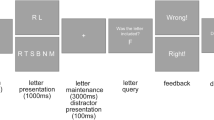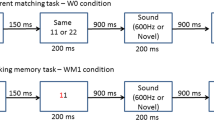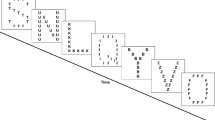Abstract
Event-related brain potentials (ERPs) were used to examine the electrophysiological effect of working memory (WM) load on involuntary attention caused by a task-irrelevant sound in an auditory–visual distraction paradigm. The different WM loads were manipulated by requiring subjects to remember the order of either three digits (low-load condition) or seven digits (high-load condition), and the irrelevant auditory stimuli consisted of repetitive standard sounds (80%) and environmental novel sounds (20%). We found that the difference waves (novel-minus-standard) showed significant MMN and Novelty-P3 components in the two WM load conditions. The amplitude of MMN increased with increasing the WM load, which indicated a more engaged change detection process under high-load condition. Then, the amplitude of Novelty-P3 was attenuated under high-load condition, which indicated a much reduced involuntary orienting of attention to novel sounds when increasing the WM load. These results indicated the top–down control of involuntary attention might be mainly active at the early change detection stage and the control of the later involuntary orienting of attention might be passive.



Similar content being viewed by others
References
Alho K, Winkler I, Escera C, Huotilainen M, Virtanen J, Skel J, Inen I et al (2001) Processing of novel sounds and frequency changes in the human auditory cortex: magnetoencephalographic recordings. Psychophysiology 35:211–224
Awh E, Vogel E, Oh SH (2006) Interactions between attention and working memory. Neuroscience 139:201–208
Berti S, Schroger E (2001) A comparison of auditory and visual distraction effects: behavioral and event-related indices. Cogn Brain Res 10:265–273
Berti S, Schroger E (2003) Working memory control involuntary attention switching: evidence from an auditory distraction paradigm. Eur J Neurosci 17:1119–1122
Berti S, Roeber U, Schroger E (2004) Bottom-up influences on working memory: behavioral and electrophysiological distraction varies with distractor strength. Exp Psychol 51:249–257
Cowan N, Morey CC (2006) Visual working memory depends on attentional filtering. Trends Cogn Sci 10:139–141
Duncan J (2001) An adaptive coding model of neural function in prefrontal cortex. Nature Rev Neurosci 2:820–829
Escera C, Corral MJ (2007) Role of mismatch negativity and novelty-p3 in involuntary auditory attention. J Psychophysiol 21:251–264
Escera C, Alho K, Winkler I, Naatanen R (1998) Neural mechanisms of involuntary attention to acoustic novelty and change. J Cogn Neurosci 10:590–604
Escera C, Alho K, Schr Ger E, Winkler I (2000) Involuntary attention and distractibility as evaluated with event-related brain potentials. Audiol Neurotol 5:151–166
Friedman D, Cycowicz YM, Gaeta H (2001) The novelty P3: an event-related brain potential (ERP) sign of the brain’s evaluation of novelty. Neurosci Biobehav Rev 25:355–373
Fuster JM (2001) The prefrontal cortex-an update: time is of essence. Neuron 30:319–333
Harmony T, Bernal J, Fernandez T, Silva-Pereyra J, Fernandez Bouzas A, Marosi E (2000) Primary task demands modulate novelty-P3 amplitude. Cogn Brain Res 9:53–60
Lavie N (2005) Distracted and confused: selective attention under load. Trends Cogn Sci 9:75–82
Lavie N, De Fockert J (2005) The role of working memory in attentional capture. Psychon Bull Rev 12:669–674
Lavie N, Hirst A, De Fockert JW, Viding E (2004) Load theory of selective attention and cognitive control. J Exp Psychol 133:339–354
Muller-Gass A, Schroger E (2007) Perceptual and cognitive task difficulty has differential effects on auditory distraction. Brain Res 1136:169–177
Muller-Gass A, Stelmack RM, Campbell KB (2006) The effect of visual task difficulty and attentional direction on the detection of acoustic change as indexed by the mismatch negativity. Brain Res 1078:112–130
Naatanen R (1990) The role of attention in auditory information processing as revealed by event-related potentials and other brain measures of cognitive function. Behav Brain Sci 13:201–288
Park SJ, Kim MS, Chun MM (2007) Concurrent working memory load can facilitate selective attention: evidence for Specialized Load. J Exp Psychol Hum Percept Perform 33:1062–1075
Pashler H, Johnston JC, Ruthruff E (2001) Attention and performance. Annu Rev Psychol 52:629–651
Postle BR (2006) Working memory as an emergent property of the mind and brain. Neuroscience 139:23–38
SanMiguel I, Corral MJ, Escera C (2008) When loading working memory reduces distraction: behavioral and electrophysiological evidence from an auditory-visual distraction paradigm. J Cogn Neurosci 20:1131–1145
Schroger E (1996) A neural mechanism for involuntary attention shifts to changes in auditory stimulation. J Cogn Neurosci 8
Spinks JA, Zhang JX, Fox PT, Gao J, Tan LH (2004) More workload on the central executive of working memory, less attention capture by novel visual distractors: evidence from an fMRI study. Neuroimage 23:517–524
Sussman E, Winkler I, Schroger E (2003) Top-down control over involuntary attention switching in the auditory modality. Psychon Bull Rev 10:630–637
Acknowledgments
This research was supported by grants from the National Natural Science Foundation of China (30800293), the Fundamental Research Funds for the Central Universities (XDJK2009B037), the Key Discipline Fund of National 211 Project and the Southwest University research Fund (SWU09103). Special thanks to Peter James Jordet for language support.
Author information
Authors and Affiliations
Corresponding author
Additional information
J.-Y. Lv and T. Wang contributed equally to this work.
Rights and permissions
About this article
Cite this article
Lv, JY., Wang, T., Qiu, J. et al. The electrophysiological effect of working memory load on involuntary attention in an auditory–visual distraction paradigm: an ERP study. Exp Brain Res 205, 81–86 (2010). https://doi.org/10.1007/s00221-010-2360-x
Received:
Accepted:
Published:
Issue Date:
DOI: https://doi.org/10.1007/s00221-010-2360-x




